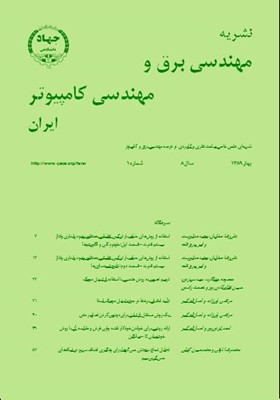تأييد امضاي برخط در حوزه تبديل موجک ايستا
محورهای موضوعی : electrical and computer engineering
مرتضی وليزاده
1
,
احساناله کبیر
2
![]()
1 - دانشگاه تربیت مدرس
2 - دانشگاه تربیت مدرس
کلید واژه: رگرسيون توسعهيافته نقاط فرينه تبديل موجک ايستا تأیید امضاي برخط جعل حرفهاي,
چکیده مقاله :
در اين تحقيق يک سيستم تأييد امضاي برخط با استفاده از روش رگرسيون توسعهيافته در حوزه تبديل موجک ايستا ارائه شده است. براي محاسبه شباهت بين امضاها بهوسيله رگرسيون توسعهيافته، بايد طول زماني سيگنالهاي متناظر دو امضا يکسان شود. استفاده از تطابق همه نقاط براي يکسانسازي طول زماني سيگنالها سبب کاهش تمايز بين امضاهاي اصلي و جعلي ميشود، براي حفظ تمايز بين امضاهاي اصلي و جعلي، روشي بر مبناي تطابق نقاط فرينه براي يکسانسازي طول زماني سيگنالها ارائه شده است. همچنين با محاسبه شباهت بين جزئيات سيگنالهاي امضاها در حوزه تبديل موجک ایستا، دقت سيستم تأييد امضا بهطور قابل ملاحظهاي افزايش داده شده است. اين سيستم بر روي مجموعه امضاهاي 2004SVC آزمايش شده و نتايج آن با نتايج تيمهاي شرکتکننده در اولين مسابقه بينالمللي تأييد امضا مقايسه شده است. با اين روش براي امضاهاي جعلي حرفهاي خطاي تأييد 6% بهدست ميآيد که در مقايسه با تيمهاي شرکتکننده در اين مسابقه در رتبه دوم قرار ميگيرد و براي امضاهاي جعلي تصادفي خطاي تأييد وجود ندارد و از اين لحاظ در رتبه اول قرار ميگيرد. نتايج حاصل نشان ميدهد که استفاده از تبديل موجک ايستا نرخ خطا را 35% نسبت به حوزه زمان بهبود ميدهد.
In this paper, an online signature verification method using extended regression in stationary wavelet domain is presented. To calculate the similarity between two signatures by extended regression, we should equalize the time length of the corresponding signals in two signatures. Using all points of the signals to equalize their time length will decrease the difference between a genuine signature and its forgery. Here a new approach based on the extreme points warping of the signals is presented. This approach equalizes the time length of two signals without degrading the differences between them. Also we calculated the similarity of signatures by using the details of the signals in stationary wavelet transform, SWT, domain, which showed very good results. The proposed system was tested on SVC2004 signature database. The results were compared with the results of participant teams in the first international signature verification competition. We have gained EER=6% for skilled forgery signatures. Comparing the result, it shows that we stand in the second rank between all the participants. This system has no verification error for random forgery signatures and stands in the first rank. Our experimental results show that using SWT domain instead of time domain decreases the verification error rate by 35%.
